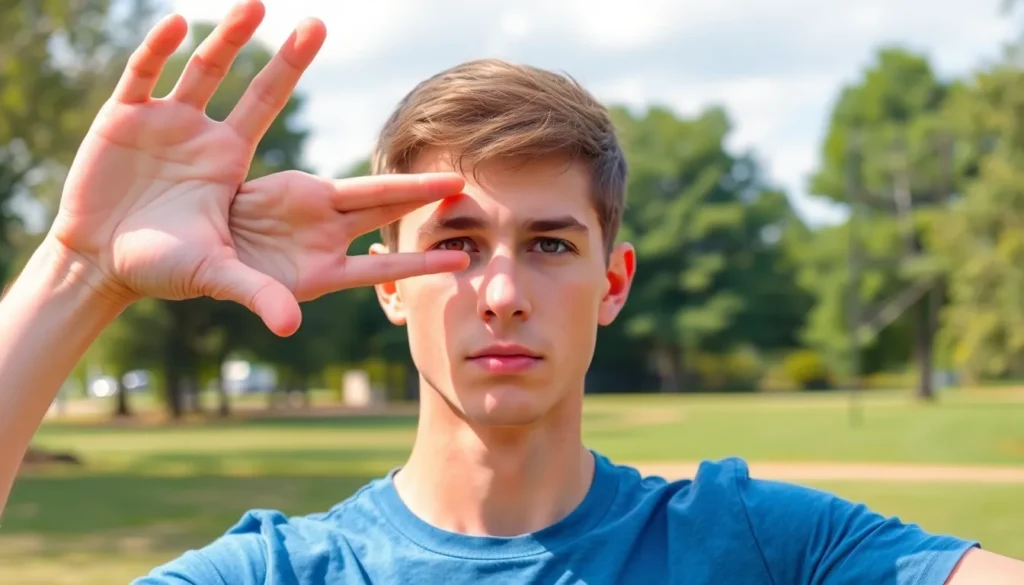Ever tried to aim at a target and felt like your eyes were playing a game of peekaboo? Finding your dominant eye could be the secret weapon you didn’t know you needed. Whether you’re a sharpshooter, an artist, or just someone who wants to ace their selfies, knowing which eye leads the charge can make a world of difference.
Table of Contents
ToggleUnderstanding Dominant Eye
The dominant eye plays a crucial role in visual perception and is essential for certain activities. Identifying this eye enhances overall performance and accuracy during tasks requiring precise focus.
Definition of Dominant Eye
The dominant eye refers to the eye that provides a greater contribution to visual input and processing. Generally, a person relies on this eye for clearer focus and better depth perception. It aids in tasks like aiming and shooting. This eye often aligns with the dominant hand but not always. Assessments can determine dominance by observing which eye a person prefers during various activities.
Importance of Identifying Dominant Eye
Recognizing the dominant eye improves performance in several activities. Shooters benefit from heightened accuracy when aiming. Artists achieve better results in sketching and painting as they gain insight into spatial relationships. Furthermore, identifying the dominant eye assists in daily tasks like photography, enhancing compositional skills. Athletes also perform better in sports requiring precise coordination. Understanding dominance facilitates improved concentration and decision-making in crucial moments.
Methods to Determine Dominant Eye

Identifying a dominant eye can be straightforward using specific methods. The following techniques offer reliable ways to determine which eye holds the advantage in visual tasks.
The Pointing Method
The pointing method involves simple finger placement. To start, participants extend their arms in front of them. They should form a small triangle with their thumbs and index fingers while focusing on a distant object. Next, individuals close one eye and then the other. The dominant eye aligns the finger triangle with the target. If the finger remains centered with one eye closed, that eye is dominant. This method offers quick insights and works well for many.
The Triangle Test
The triangle test requires a similar approach but emphasizes visual alignment. Individuals need to create a triangle with their hands while focusing on an object far away. After positioning their hands, they should close one eye at a time. The eye that keeps the object in view while remaining centered within the triangle indicates dominance. This method provides a simple yet effective way to recognize the dominant eye, applicable for activities that demand precise visual input.
Other Techniques
Several techniques exist to further identify the dominant eye. They enhance identification accuracy and provide practical approaches to visual perception.
Using a Camera
Using a camera offers a unique method for determining eye dominance. He or she can extend their arms and frame a distant object through the viewfinder. While aiming, participants can close each eye alternately, observing which eye keeps the object in focus. This technique shows the more dominant eye based on the ease of alignment with the target. Many photographers leverage this method to improve their accuracy in capturing images.
Observing Eye Movement
Observing eye movement provides another insightful technique to find the dominant eye. Individuals can focus on an object across the room. They should notice which eye leads when tracking the object, with its movement reflecting dominance. If one eye consistently aligns with the object more smoothly than the other, that eye is likely dominant. This simple observation helps in understanding how visual attention directs focus during various tasks.
Practical Applications
Identifying the dominant eye plays a key role in various aspects of performance and visual tasks. The benefits extend beyond simple observation, influencing sports performance and vision correction.
Impact on Sports Performance
In sports, eye dominance significantly affects accuracy and reaction time. Athletes often excel in activities like shooting, archery, or baseball by aligning their dominant eye with their target. Enhanced hand-eye coordination stems from knowing which eye provides the clearest view, leading to more accurate shots and faster decisions during games. Research shows that athletes aware of their dominant eye can improve their strategic play and achieve better results in competitive scenarios.
Implications for Vision Correction
Understanding eye dominance aids in vision correction strategies. During eye exams, optometrists consider which eye is dominant when prescribing corrective lenses. For individuals receiving treatment for conditions like amblyopia, knowing the dominant eye helps prioritize therapy. Proper alignment of lenses with the dominant eye enhances visual clarity. Consequently, effective vision correction leads to improved daily functioning and enhances overall quality of life.
Identifying the dominant eye can profoundly impact various activities and enhance overall performance. Whether in sports, art, or photography, knowing which eye leads can improve focus and accuracy. By utilizing simple methods like the Pointing Method or the Triangle Test, anyone can quickly determine their dominant eye.
This knowledge not only aids in achieving better results but also plays a role in vision correction strategies. Understanding eye dominance can lead to improved coordination and decision-making in critical moments. Embracing this insight can elevate skills and boost confidence in everyday tasks and specialized pursuits alike.




